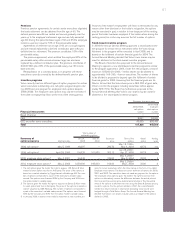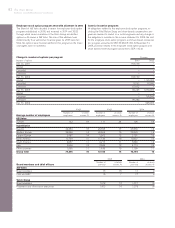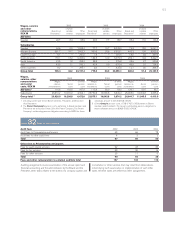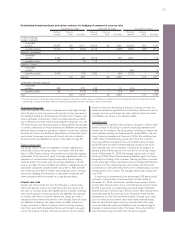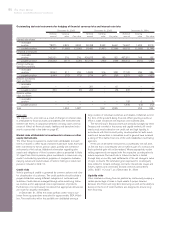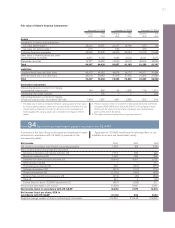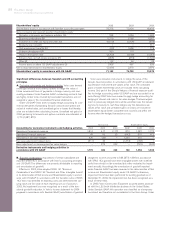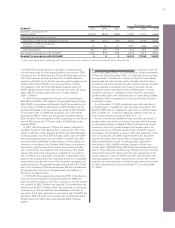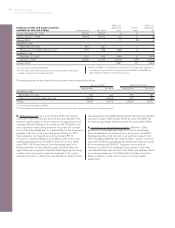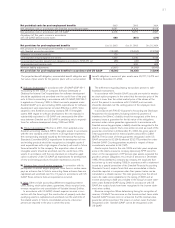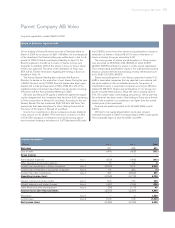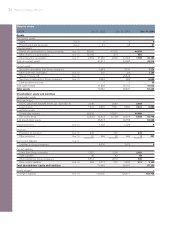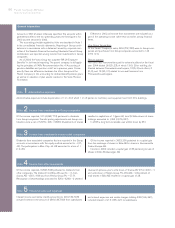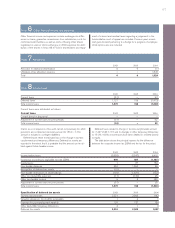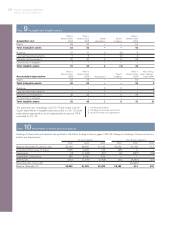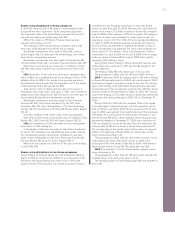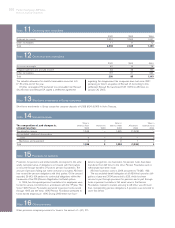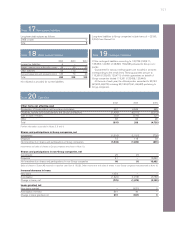Volvo 2004 Annual Report Download - page 93
Download and view the complete annual report
Please find page 93 of the 2004 Volvo annual report below. You can navigate through the pages in the report by either clicking on the pages listed below, or by using the keyword search tool below to find specific information within the annual report.
91
F. Software development. In accordance with US GAAP (SOP 98–1
“Accounting for the Costs of Computer Software Developed or
Obtained for Internal Use”) expenditures for software development
should be capitalized and amortized over the useful lives of the proj-
ects. In Volvo’s accounting in accordance with US GAAP, SOP 98–1
is applied as of January 1999. In Volvo’s accounts prepared under
Swedish GAAP up to and including 2000, expenditures for software
development were expensed as incurred. Effective in 2001, Volvo
adopted a new Swedish accounting standard, RR 15 Intangible
assets. With regard to software development, the new standard is
substantially equivalent to US GAAP and consequently the differ-
ence between Swedish and US GAAP is pertaining only to expendi-
tures for software development during 1999 and 2000.
G. Product development. Effective in 2001, Volvo adopted a new
Swedish accounting standard, RR15 Intangible assets. In accordance
with the new standard, which conforms in all significant respects to
the corresponding standard issued by the International Accounting
Standards Committee (IASC), expenditures for development of new
and existing products should be recognized as intangible assets if
such expenditures with a high degree of certainty will result in future
financial benefits for the company. The acquisition value of such
intangible assets should be amortized over the useful lives of the
assets. In accordance with the new standard, no retroactive appli-
cation is allowed. Under US GAAP, all expenditures for development
of new and existing products should be expensed as incurred.
H. Entrance fees, aircraft engine programs. In connection with its
participation in aircraft engine programs, Volvo Aero in certain cases
pays an entrance fee. In Volvo’s accounting these entrance fees are
capitalized and amortized over 5 to 10 years. In accordance with US
GAAP, these entrance fees are expensed as incurred.
I. Other. Other include accounting differences regarding interest
costs, leasing, stock option plans, guarantees, Alecta surplus funds,
revenue recognition and consolidation of Variable Interest Entities.
In accordance with US GAAP, interest expense incurred in con-
nection with the financing of the construction of property and other
qualifying assets is capitalized and amortized over the useful life of
the related assets. In Volvo’s consolidated accounts, interest ex-
penses are reported in the year in which they arise.
The differences regarding leasing transactions pertain to sale-
leaseback transactions.
In accordance with Swedish GAAP, accruals are made for employ-
ee stock option programs to the extent that the exercise price of the
options is lower than the actual market price of the shares at the
end of the period. In accordance with US GAAP, such accruals
should be allocated over the vesting period of the employee stock
option program.
In accordance with FIN 45 “Guarantor’s Accounting and Disclosure
Requirement for Guarantees, Including indirect Guarantees of
indebtness for Others”, a liability should be recognized at the time a
company issues a guarantee for the fair value of the obligations
assumed under certain guarantee agreements. In accordance with
Swedish accounting principles, a liability should be recognized to the
extent a company expects that a loss will be incurred as result of the
guarantee commitment. At December 31, 2004, the gross value of
credit guarantees issued for external parties amounted to 2,869
(3,879). The fair value of these guarantees recognized under US
GAAP amounted to 92 (244), whereof 82 (217) provided for under
Swedish GAAP. Counterguarantees received in respect of these
commitments amounted to 56 (167).
Alecta surplus funds. In the mid-1990s and later years surpluses
arose in the Alecta insurance company (previously SPP) since the
return on the management of ITP pension plan assets exceeded the
growth in pension obligations. As a result of decisions in December
1998, Alecta distributed, company by company, the surpluses that
had arisen up to and including 1998. In accordance with a statement
issued by a special committee of the Swedish Financial Accounting
Standards Council, surplus funds that were accumulated in Alecta
should be reported in companies when their present value can be
calculated in a reliable manner. The rules governing how the refund
was to be made were established in the spring of 2000 and an
income amounting to 683 was included in the Group’s income state-
ment under Swedish GAAP during 2000. In accordance with US
GAAP, the surplus funds have been recognized in the income state-
ment when settled.
Revenue recognition. When determining timing for recognition of
revenue, US GAAP focuses more on the formal contract terms while
Swedish GAAP focuses more on actual risk that the residual value
guarantee will be exercised. This means in certain cases that sales
recognised under Swedish GAAP cannot be recognised under
US GAAP.
Net periodical costs for post-employment benefits 2002 2003 2004
Net periodical costs in accordance with Swedish accounting principles 5,087 4,424 4,414
Net periodical costs in accordance with US GAAP 4,418 5,075 4,687
Adjustment of this year’s income in accordance
with US GAAP, before income taxes 669 (651) (273)
Net provisions for post-employment benefits Dec 31, 2002 Dec 31, 2003 Dec 31, 2004
Net provisions for post-employment benefits in accordance
with Swedish accounting principles (15,528) (15,094) (13,784)
Difference in actuarial methods 170 – –
Unrecognized actuarial (gains) and losses 1,350 5,296 4,733
Unrecognized transition (assets) and obligations according to SFAS 87, net (33) (29) (15)
Unrecognized past service costs – 659 602
Minimum liability adjustments (1,507) (4,268) (4,542)
Net provisions for post-employment benefits in accordance with US GAAP (15,548) (13,436) (13,006)
The projected benefit obligation, accumulated benefit obligation and
fair value of plan assets for the pension plans with an accumulated
benefit obligation in excess of plan assets were 20,157; 19,472 and
14,722 at December 31, 2004.


